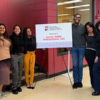ESU Celebrates Campus Arboretum with New Tree Guide

Posted by: Elizabeth Richardson on April 17, 2018, No Comments
Robin Hill Pink Shadblow with fuzzy purple leaves, purple filaments and powder-blue anthers.
Katsura, whose heart-shaped leaves smell like burnt sugar or cotton candy when they fall in autumn.
Silky Stewartia, with woody egg-shaped fruits that open to reveal shiny brown seeds.
Golden Rain Tree, with its papery, lantern-shaped fruits.
Names to quicken the pulse of any tree lover.
And they, along with the Ruby Horse Chestnut, the Star Magnolia, the Fastigiate Hornbeam and dozens of others, are all to be found on the campus of East Stroudsburg University.
A new Arboretum Guide provides a tour of 48 different species from among the countless trees comprising the 100-acre arboretum, the landscaped portion of the 258-acre campus. The guide will be presented on Thursday, April 19, at 2:00 p.m. for the spring opening of the Arboretum. Opening remarks will be held in Stroud Hall, Room 113. Student led tours will follow. The event also includes planting of a new tree. The Arboretum Guide will be available in print at the admission desk of the Schisler Museum and McMunn Planetarium, located on the ground floor of the Warren E. & Sandra Hoeffner Science and Technology Center and in the biology department located on the ground floor of Moore Biology Hall.
The guide is an initiative of the ESU Sustainability Commission and the ESU Environmental Club, spearheaded by club president and graduate student Weston Strubert ’16 M ’19 of Bartonsville and funded by the Office of the Dean and the Student Activity Association.
Strubert is frankly crazy about plants, especially trees, a passion arising from his study of forest structures and ecosystems. Working on a double master’s degree in biology/ecology and general science/GIS and remote sensing technology, Strubert felt sharing information about the beauty and diversity of ESU’s arboretum was important. “The best part is being able to inform others, to spread information to non-science majors and the community,” he says with enthusiasm.
The project involved 28 Environmental Club members, working with plant ecologist Emily Rollinson, Ph.D., assistant professor of biology, to catalog, identify, accurately classify and map the trees. The guide is divided into several campus areas, and each tree listed in the guide is also marked with a plaque giving both common and botanical names. They also plan to eventually expand the guide, adding additional trees and including a large number of native species.
Although they didn’t realize it as they began work, an arboretum guide had been published in 1993 by now emeritus professor of biology Raymond Milewski, Ph.D., for the University’s Centennial. Able to use the old guide as a starting point made the job considerably easier. (And, by coincidence, the new guide also now commemorates ESU’s 125th Anniversary.)
“The arboretum is a great resource for the campus and the local community, helping us recognize the natural diversity around us,” says Dr. Rollinson. She stresses that the guide is a student-driven project and “a labor of love” for Strubert, noting that it speaks not only to the students’ stake in biology and ecology but to their commitment to the University.
Dean of the College of Arts and Sciences Peter Hawkes, Ph.D., is proud of the students’ work. “We have a powerful environmental studies program that benefits from our location in the Pocono Mountains, with its streams and glacial lakes, and opportunities for field studies, and that holds true for the campus, with its multitude of different species of trees. There is so much to see.”
As for Weston Strubert, he urges both campus and local communities to take some time to stroll the Arboretum and relish the beauty of all those fascinating trees.
Search
Recent Posts

Julianna and Wayne Bolt Art Contest Winners Selected for the 29th Annual Martin Luther King Jr. Celebration
December 10, 2025 - Read more

ESU Hosts 8th Annual Dr. Barbara G. Collins Social Work Professional Development Day
December 4, 2025 - Read more

ESU Professor Elected to American Society of Plant Biologists Steering Committee
November 25, 2025 - Read more

